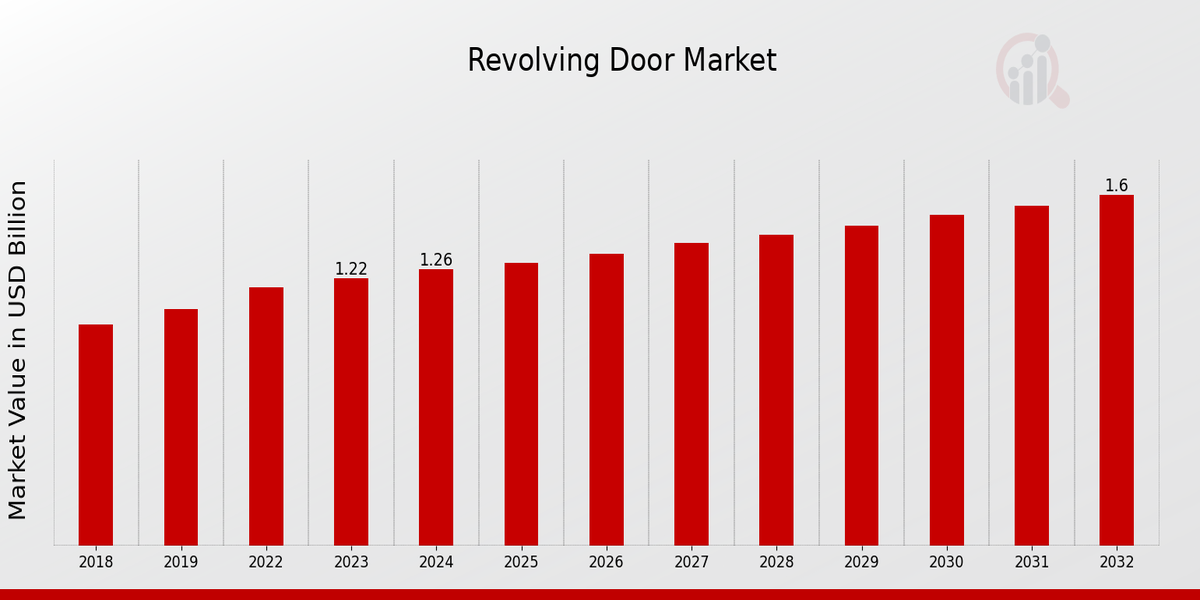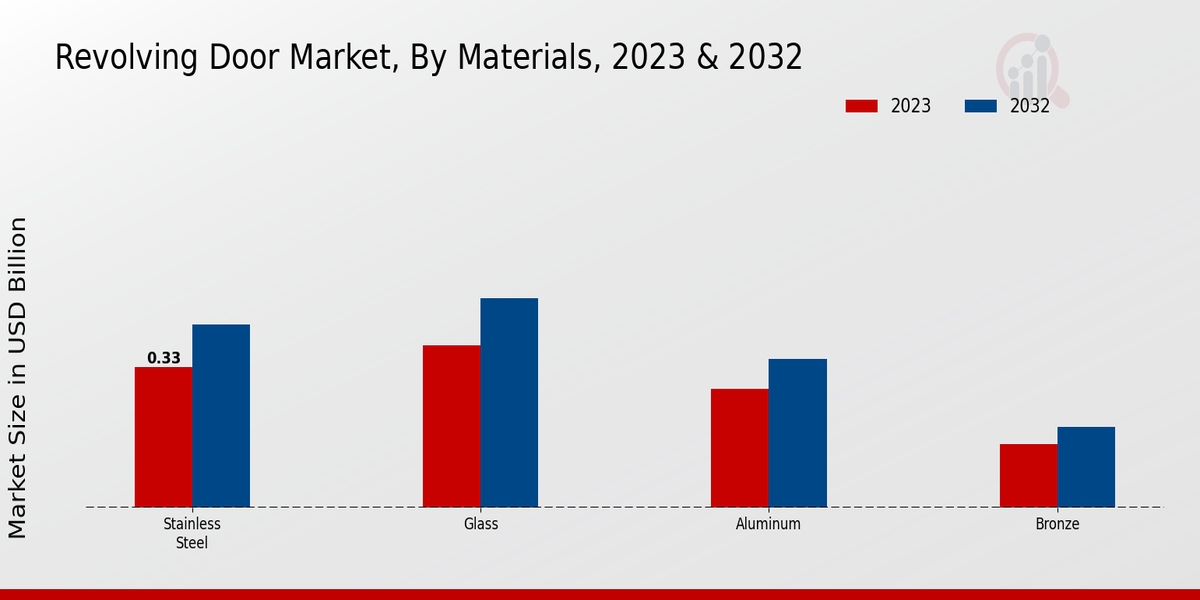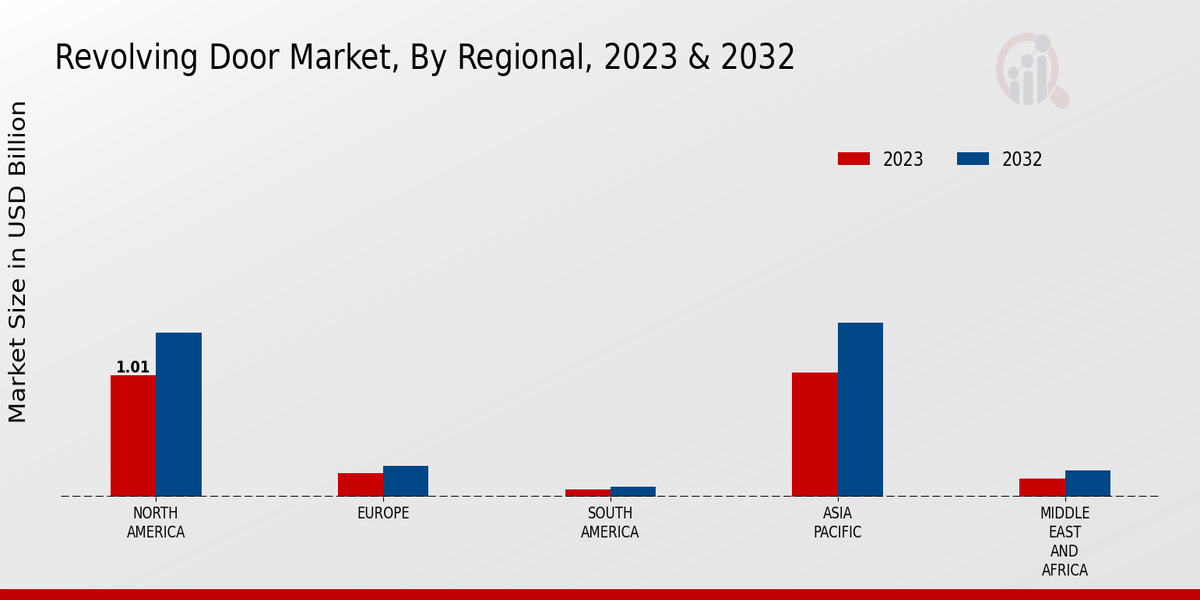Global Revolving Door Market Overview
The Revolving Door Market Size was estimated at 1.18 (USD Billion) in 2022. The Revolving Door Industry is expected to grow from 1.22(USD Billion) in 2023 to 1.6 (USD Billion) by 2032. The Revolving Door Market CAGR (growth rate) is expected to be around 3.07% during the forecast period (2024 - 2032).
Key Revolving Door Market Trends Highlighted
The Revolving Door Market is experiencing notable trends that shape its development. Increasing demand for sustainable and energy-efficient building solutions is driving the adoption of revolving doors, which effectively reduce energy loss and enhance indoor air quality. Technological advancements are fueling innovation, with automated and touchless entry systems gaining traction. The rising emphasis on accessibility and safety regulations is influencing product designs and features, including wider doorways and integrated accessibility features.
Customization and aesthetics are becoming key considerations as businesses and architects seek to enhance the visual appeal and functionality of their entrances. Moreover, the growing preference for revolving doors in high-traffic commercial and public spaces indicates their durability and capacity to handle significant pedestrian flow.

Source: Primary Research, Secondary Research, MRFR Database and Analyst Review
Revolving Door Market Drivers
Rising Demand for Enhanced Security and Safety
The growing worries over security violations and the need to protect people and assets have driven the demand for revolving doors in the Revolving Door Market Industry. These doors serve as a controlled access point, barring unauthorized entry and letting authorized personnel through smoothly. With the inbuilt capability of detecting and resisting any tailgating attempts, these structures integrate a range of cutting-edge safety measures, such as biometric scanners and surveillance cameras.This factor makes them a primary choice for high-security establishments, including government agencies, corporate buildings, and financial institutions. The modern-day focus on the well-being of employees and the appeal of remaining compliant with stringent regulations continue to drive the adoption of revolving doors, as they rule out the genuine risk of accidents and injuries connected with their swinging or sliding counterparts.
Increasing Focus on Energy Efficiency
The increasing price of energy and the rising focus on green building practices have created a demand for energy-efficient revolving doors in the Revolving Door Market Industry. Designed to reduce heat loss effectively, these doors have a reduced impact on the environment and help save expenses. An airtight seal and efficient airlocks stop drafts and seal indoor temperatures, and motion sensors and variable-speed drives help the use of energy as based on the number of people entering or exiting.
Growing Adoption in Commercial and Public Spaces
Revolving doors have gained immense popularity in commercial and public spaces owing to their aesthetic appeal, space optimization, and accessibility features. Their elegant designs complement modern architectural styles, enhancing the overall aesthetics of buildings. The compact footprint of revolving doors makes them ideal for space-constrained areas, allowing for efficient use of available space. Moreover, their accessibility features, such as wheelchair ramps and automatic door openers, ensure inclusivity and ease of access for individuals with disabilities.These factors contribute to the growing adoption of revolving doors in shopping malls, airports, hotels, and other high-traffic public spaces.
Revolving Door Market Segment Insights
Revolving Door Market Materials Insights
The choice of materials used in revolving doors significantly impacts their functionality, aesthetics, and durability. The Revolving Door Market is segmented into various materials, including Stainless Steel, Glass, Aluminum, and Bronze. Each material offers distinct advantages and considerations, catering to specific industry requirements and preferences. Stainless steel is a popular choice due to its exceptional durability, resistance to corrosion, and ability to withstand heavy usage. Its strength and longevity make it ideal for high-traffic applications, such as commercial buildings, airports, and shopping malls.The Revolving Door Market revenue for stainless steel revolving doors is projected to reach USD X billion by 2026, exhibiting a steady growth rate. Glass revolving doors offer a sleek and modern aesthetic, maximizing natural light and enhancing visibility. They are commonly found in architectural landmarks, office buildings, and luxury hotels. The Revolving Door Market data indicates a growing demand for glass revolving doors, with the market expected to reach a substantial market share by 2032. Aluminum revolving doors are lightweight, corrosion-resistant, and customizable, making them a versatile option for various applications.They are often preferred in coastal areas due to their ability to withstand harsh weather conditions. The Revolving Door Market Statistics project a significant market share for aluminum revolving doors, reaching a notable market share by 2032. Bronze revolving doors provide a classic and elegant appearance, often used in historical buildings and government institutions. Their durability and resistance to wear make them suitable for high-end applications. The choice of materials for revolving doors depends on factors such as aesthetics, durability, traffic volume, and energy efficiency. As the industry continues to evolve, innovative materials and technologies are emerging to meet the growing demands of the Revolving Door Market.

Source: Primary Research, Secondary Research, MRFR Database and Analyst Review
Revolving Door Market Diameter Insights
The Revolving Door Market is segmented by Diameter into 3m, 3.5m, 4m, 4.5m, and 5m. Among these, the 3m segment is expected to hold the largest market share in 2023, accounting for around 35% of the Revolving Door Market revenue. The 3.5m segment is projected to follow closely with a market share of approximately 30%. The growth of these segments can be attributed to the increasing demand for revolving doors in commercial buildings, particularly in regions with high pedestrian traffic. The 4m, 4.5m, and 5m segments are also anticipated to experience steady growth, driven by the growing popularity of revolving doors in large-scale infrastructure projects, such as airports and shopping malls.By 2032, the 3m segment is expected to reach a valuation of USD 420 million, while the 3.5m segment is projected to reach USD 360 million. The 4m, 4.5m, and 5m segments are anticipated to reach valuations of USD 280 million, USD 210 million, and USD 140 million, respectively.
Revolving Door Market Type Insights
The Revolving Door Market is segmented by Type into Automatic, Manual, and Semi-Automatic. The Automatic segment held the largest market share in 2023 and is expected to continue to dominate the market during the forecast period. The growth of the Automatic segment can be attributed to the increasing adoption of automated solutions in commercial and public buildings. Automatic revolving doors offer several advantages over manual and semi-automatic doors, such as improved energy efficiency, enhanced security, and increased convenience for users.
The Manual segment is expected to witness a steady growth rate during the forecast period. Manual revolving doors are typically less expensive than automatic doors and are often preferred in applications where cost is a primary consideration. Manual doors are also suitable for areas with limited space, as they do not require any additional machinery or electrical connections. The Semi-Automatic segment is expected to grow at a moderate pace during the forecast period. Semi-automatic revolving doors offer a compromise between the convenience of automatic doors and the cost-effectiveness of manual doors.These doors are typically equipped with a sensor that activates the motor to open the door when a person approaches, and then the person manually pushes the door open the rest of the way.
Revolving Door Market Mechanism Insights
The Revolving Door Market is segmented based on mechanism into swing, sliding, and folding. Among these, the swing mechanism segment held the largest market share in 2023 and is expected to continue its dominance throughout the forecast period. The swing mechanism offers several advantages, including ease of use, durability, and cost-effectiveness. It is commonly used in various commercial and residential buildings, contributing to its widespread adoption. The sliding mechanism segment is projected to witness significant growth during the forecast period.Sliding revolving doors provide a space-saving solution, making them suitable for areas with limited space. They are often used in high-traffic areas, such as airports and shopping malls, where maximizing space utilization is crucial. The folding mechanism segment is anticipated to grow at a steady pace over the forecast period. Folding revolving doors offer a unique combination of space efficiency and aesthetic appeal. They are gaining popularity in modern architectural designs, particularly in commercial buildings and luxury residential complexes.
Revolving Door Market Regional Insights
The Revolving Door Market is segmented into North America, Europe, APAC, South America, and MEA. In 2023, North America held the largest share of the Revolving Door Market, accounting for around 35% of the revenue. Europe followed with approximately 20% of the market share. APAC is expected to witness the highest growth rate during the forecast period, owing to the increasing construction activities in the region. The emerging economies in APAC, such as China and India, are expected to drive the growth of the Revolving Door Market in the region.South America and MEA are expected to hold a relatively smaller share of the Revolving Door Market in 2024 but are also expected to witness steady growth over the forecast period.

Source: Primary Research, Secondary Research, MRFR Database and Analyst Review
Revolving Door Market Key Players And Competitive Insights:Leading Revolving Door Market companies are using various strategies to secure a dominant share in the Revolving Door Market industry. Partnerships, mergers, acquisitions, collaborations, and agreements are some of the strategies major Revolving Door Market companies implement to get a competitive advantage in the Revolving Door Market industry. In addition, Revolving Door Market development requires significant investment and resources due to stringent regulatory requirements. The strict requirements make it difficult for new entrants to enter the Revolving Door Market Industry market. As a result, it reduces the level of competition in the Revolving Door Market Competitive Landscape, leading to a consolidated market structure characterized by a few Revolving Door Market Players. Some of the major players in the Revolving Door Market Industry include the following.
DORMA is one of the leading Revolving Door Market companies globally. The company has an extensive range of revolving doors, including manual, automatic, and high-security revolving doors. The company's revolving doors are highly durable, reliable, and visually appealing. The firm has a strong presence in the international market, and it has installed its revolving doors in some of the most prestigious buildings in the world.
Boon Edam is another leading Revolving Door Market company on a global scale. The company offers a variety of revolving doors, including Classic, Crystal, and Circle models. Boon Edam revolving doors satisfy the requirements of all kinds of applications, from commercial buildings to airports. The company has a vast network of distributors and partners at the international level that helps it provide its products and services around the globe.
Key Companies in the Revolving Door Market Include
- Record
- Johnson Controls
- Assa Abloy
- KONE
- Schindler
- Besam
- Otis
- Gilgen Door Systems
- Dorma
- Tormax
- Boon Edam
- Hirt
- Manusa
- ThyssenKrupp
- Automatic Systems
Revolving Door Market Industry Developments
The Revolving Door Market is projected to reach USD 1.6 billion by 2032, exhibiting a CAGR of 3.07% during the forecast period (2024-2032). Increasing demand for revolving doors in commercial buildings, airports, and public spaces, coupled with growing urbanization and infrastructure development, is driving market growth. Technological advancements, such as touchless and automatic door systems, are further propelling market expansion. Key industry participants include Boon Edam, Dormakaba, and ASSA ABLOY, who are focusing on product innovation and strategic partnerships to maintain their competitive edge.
Revolving Door Market Segmentation Insights
- Revolving Door Market Materials Outlook
- Stainless Steel
- Glass
- Aluminum
- Bronze
- Revolving Door Market Diameter Outlook
- Revolving Door Market Type Outlook
- Automatic
- Manual
- Semi-Automatic
- Revolving Door Market Mechanism Outlook
| Report Attribute/Metric |
Details |
| Market Size 2022 |
1.18(USD Billion) |
| Market Size 2023 |
1.22(USD Billion) |
| Market Size 2032 |
1.6(USD Billion) |
| Compound Annual Growth Rate (CAGR) |
3.07% (2024 - 2032) |
| Report Coverage |
Revenue Forecast, Competitive Landscape, Growth Factors, and Trends |
| Base Year |
2023 |
| Market Forecast Period |
2024 - 2032 |
| Historical Data |
2019 - 2023 |
| Market Forecast Units |
USD Billion |
| Key Companies Profiled |
Record, Johnson Controls, Assa Abloy, KONE, Schindler, Besam, Otis, Gilgen Door Systems, Dorma, Tormax, Boon Edam, Hirt, Manusa, ThyssenKrupp, Automatic Systems |
| Segments Covered |
Materials, Diameter, Type, Mechanism, Regional |
| Key Market Opportunities |
Energy efficiency integration of advanced technologies customization growth in developing regions emerging green building construction |
| Key Market Dynamics |
Increased Aesthetics Enhanced Security Growing Infrastructure Sustainable Building Practices Technological Advancements |
| Countries Covered |
North America, Europe, APAC, South America, MEA |
Frequently Asked Questions (FAQ) :
The revolving door market is expected to be valued at 1.22 billion USD in 2023.
The revolving door market is expected to grow at a CAGR of 3.07% from 2024 to 2032.
The key regions for the revolving door market are North America, Europe, Asia-Pacific, and the Rest of the World.
The major applications of revolving doors include commercial buildings, hospitals, airports, and shopping malls.
The key competitors in the revolving door market include Boon Edam, Dormakaba, and ASSA ABLOY.
The growth drivers for the revolving door market include increasing demand for energy-efficient building solutions, rising urbanization, and growing construction activities.
The challenges faced by the revolving door market include high manufacturing costs, competition from other types of doors, and stringent safety regulations.
The key trends in the revolving door market include the adoption of smart revolving doors, the use of sustainable materials, and the integration of access control systems.
The revolving door market is expected to reach a value of 1.6 billion USD by 2032.
The key opportunities for the revolving door market include the growing demand for automated and energy-efficient building solutions, the increasing focus on sustainability, and the rise of smart cities.





























